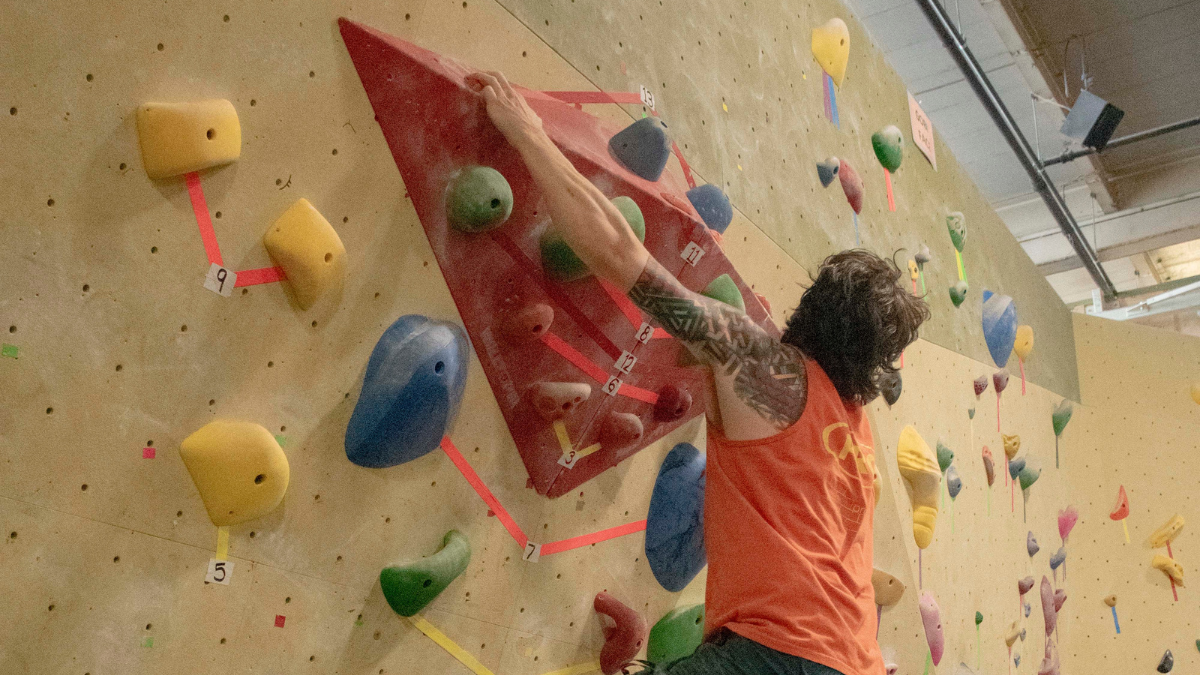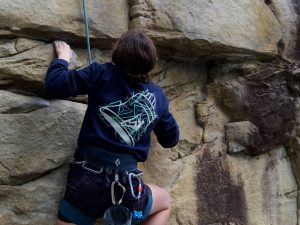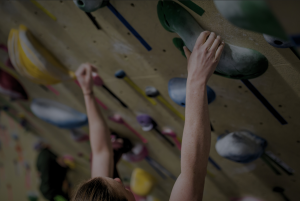Now that you understand the mechanics of double dynos and single dynos, we will finish this skill with some final tips to allow you to hone your abilities and gain greater distance and precision.
The Lower you Go, the Further you Throw
One of the best ways to ruin a dyno is to start with your arms bent. I find that it is useful to think of your arms like rubber bands on such moves. If you want to shoot a rubber band at your classmate, you will pull it back as far as it will go, and release it from that point.
In an analogous fashion, to get the greatest distance from a dyno, you must first start with your arms as fully extended as possible. I recommend you feel as if your shoulders are squeezing your neck.
This position will result in your hips drifting from the wall and off of your feet. But in this case, that is a small and temporary price to pay. Once you begin the dyno from this position, you will be arching your back and trying to get your hips in and over your motion point. Do this while still keeping your arms straight.
In addition to saving energy, this process also creates a great deal of tension in your body. This tension, when released through rotating around your pivot point (i.e. your hands) will be translated into rotational and eventually upward motion. This will increase your distance in proportion to how straight your arms were.
Pumping doesn't help!
Many climbers when starting a dyno will swing up and down a few times before finally committing to the move. Most claim that this is to generate extra momentum to increase their distance. But secretly they will frequently admit that it’s really to psyche themselves up for the throw!
Whatever the reason, avoid this pumping motion. It actually works against you in nearly all cases.
The reason is simple.
First, if you are swinging up and down at the beginning of a move you are wasting time, which as we have discussed is wasting energy.
Second, you are dropping extra weight on your hands (by having to counteract your downward momentum) just as you are about to enlist to do the dyno. It is difficult to see how having to overcome that additional momentum will actually increase your distance in the opposite direction!
Exceptions to This Rule
The two exceptions to this are the single pump, and sideways dynos.
The single pump is simply doing one upward swing, before dropping down to the proper starting position. This can be useful (sometimes) because the downward momentum can actually lengthen your muscles slightly more than by using only your own static weight.
This tiny additional length to your arms can be magnified through the magic of physics to additional upward momentum once you enlist–if your timing is perfect. Any additional swings, however, do not confer any benefit, and will likely just tire you out.
Dynos with a significant sideways component may occasionally benefit from additional swings to generate sideways momentum.
However, such benefits should always be weighed against the loss of energy from holding on during the swing. In my experience, it is rare that multiple swings result in an increase in distance on such dynos, as compared to one good “pull back and throw.”
Time to Get Technical: Conserve Angular Momentum
Here we get to perhaps the most technical part of this article. It is that the full understanding that dynos are a form of rotational motion, rather than, truly, pushing.
As we have previously discussed, when observed from the side, dynos are more akin to swinging around your hands (the pivot point) than they are to jumping or throwing for a hold.
In fact, it is the translation of our rotational motion, at the last instant, into motion up the plane of the wall that gives us the ability to dyno more than a body length from handhold to handhold. Obtaining the same distance by simply jumping would require a vertical leap of four feet or more!
Because of this fact, a key feel to develop in a dyno is how to increase your angular momentum. Luckily this is actually quite simple.
In effective movement, the arms should be seen as points for balance and direction, not for doing large amounts of pulling work. In a dyno, this is a key principle.
Although we do some pulling to initiate movement for a dyno, bending our arms does little to directly aid our upward momentum, not when compared to the power from our legs and the rotational motion.
Think of a Dyno as Tetherball
But it is in regard to that rotational motion where our arms can offer the most benefit. It’s not by pulling to add to our upward motion, but by reducing the length of the “string” which attaches up to the wall.
As a reminder, in a dyno, the hips rotate around the pivot point (the starting hold) in much the same way that a tetherball would around a pole in the ground. The tetherball is attached to the pole with a string, and the tension on that string is what keeps the ball spinning around the pole. In an analogous fashion, our arms, like the string, keep the tension between the pivot point and our hips as we rotate up the wall.
What happens to a tetherball in motion when you shorten the string? It goes faster!
This is similar to what happens to a figure skater in a pirouette. When she begins spinning her arms are out wide. As the movement continues, she pulls her arms into her body, and her speed increases.
In much the same way, a climber adds speed to the end of a dyno by bending her arms before she lets go. This bend not only allows her to keep her hips as close to the wall as possible at the time of release, but it also shortens the “string” which attaches her to the wall, increasing her speed and thereby gaining her upward distance.
For those of you who are scientifically inclined, the principle at work here is the conservation of angular momentum. Shortening the string, or your arms (through bending them), increases your speed to compensate for the overall change in the momentum of the system. Neat, huh?
The Alligator Flip
This last trick is to reinforce the real power of the conservation of momentum skill we just discussed.
This trick was first described by a world-class boulderer, Klem Loscot who used it to stick one of the hardest dynos in the world.
The principle is the same as the previous example, except this time we are focused on your head. When executing a dyno the trick is to keep your head tilted back until just before you grab the target hold.
Then, as you reach the deadpoint, flick your head forward. The principle is the same as with bending your arms–flicking your head forward “shortens the string” as it were by a tiny amount.
This process speeds up your angular momentum a small amount and, according to Klem, can increase your final distance by up to an inch.
Common Errors to Avoid
Avoid pausing during a dyno.
Avoid pulling in with your arms to start a dyno.
Quick Tips
Aim an inch above the hold you are throwing for.
Keep your arms as straight as possible for as long as possible.
The lower you go, the farther you throw.
All material is reprinted with the permission of the author. Copyright 2022 David H. Rowland. All rights reserved.









